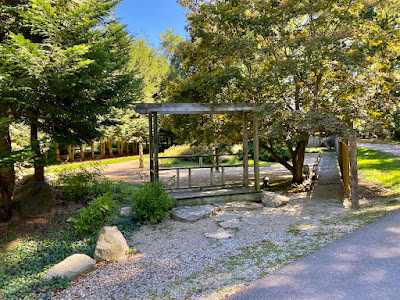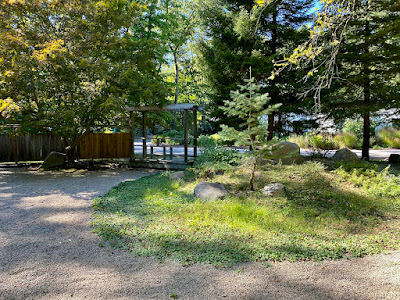I stumbled upon Fernwood Botanic garden while driving through west Michigan. Its origins date back to 1941, and was later opened as a public garden in 1964. In total, there is 105 acres of gardens at the site.
My interest was peaked by a Google search which indicated that a Japanese garden was included within the overall gardens and had been designed by Ben Oki, one of the world's leading masters of the art of bonsai and curator of the Huntington Botanical Garden bonsai collection (he has been deceased since 2019).
I did not have a lot of time to explore Fernwood Gardens, and only planned on viewing the Japanese garden. Unfortunately, upon my arrival to the Japanese garden I was somewhat disappointed. It was not well maintained and overgrown.
Locating historical information about this Japanese garden was difficult. Its location seemed a bit odd - directly adjacent to a "Train Garden" with actual model trains running through it.
The image below shows a long row of trees planted between these two gardens, but the tree row does not hide one garden from the other (perhaps in the past it did.) A fence or wall behind these tree would better demarcate the edge of the two gardens.
The stone lined pathway was a good way to allow visitors to walk the perimeter, but the stones needed resetting. There also benches along the edge, but they appeared more European.
A nearby metal lantern sits near the corner, but needs some rethinking as well as maintenance.
This area also seems to mark the entry way into the garden and provided a viewing platform from which to take in the view of the the "Gravel Sea" and "Turtle and Crane Islands" within. The platform was glaringly not Japanese in style. It appears to be a more recent addition.
On the other hand, the platform helps to provide visitors with some context about Japanese gardens. Fortunately, there were two small plaques attached to the viewing platform. I did not see these at first, but once read, they helped me better understand the layout of the entire garden (discussed in more detail below).
It also serves the practical task of stopping visitors from randomly walking into the gravel bed which is meant to be contemplated at a distance. A small teahouse would probably be a better structure to add.
At the far end of the fence/path line, resided an interesting cast concrete lantern. Again, authenticity was off, but I did like the cast "tree" logo along the top - I haven'y seen that before.
I was not sure of the grass feature at the corner. Seemed unkept and unexplained.
Reading the two small plaques at the viewing platform, I discovered that the garden is called "The Garden of Petal and Sea," and is a traditional Zen garden meant to allow visitors to contemplate the "Blessed Isles" where the immortals reside and mortals cannot.
The island below represents a Crane Island with two tall rocks representing the crane's uplifted wings.
 |
| Crane Island |
 |
| Crane Island |
 |
| Crane Island |
 |
| Crane Island |
Unfortunately, I did not see or envision the crane or the additional rocks representing "Shumisen, the center of the universe with its eight surrounding mountain ranges thrust skyward on the highest points of the islands." The islands were simply too overgrown and seemingly unkept.
To the left of the viewing platform (right in the picture below) was the Turtle Island. I did not see this feature at first, and I have documented many turtle islands in both Japan and in North America. Had it not been for the small plaque at the viewing platform, I would have missed it.
From the viewing platform one can realize the uplifting head of the turtle and possibly its feet. Unfortunately, for me, it was a struggle to do so.
Taking in the "The Garden of Petal and Sea" as a whole, I came to appreciate the design, if not the maintenance. The garden was built 45 years ago, back in 1979, and many years have passed since it was first planned and planted. I recognize that Japanese gardens like these are difficult to maintain, and I applaud the garden staff for working with their limited resources and budget to ensure the survival of this garden. Japanese gardens like these are meant to evolve, but they are never natural. They require constant human attention.
Ben Oki's original plan is well thought out. What this garden needs today is some additional love and care. Of course, as usual, money and budgets dictate the care that a garden receives. Garden loving benefactors can fill that void.
In this case I would advocate for the students of Ben Oki to consider the significance of the garden, designed by their master, and a lasting legacy to his memory. The possibility of gathering support from the hundreds of people who were inspired by his efforts to bring Japanese gardening to North America could help to ensure that the The Garden of Petal and Sea continues to bring joy to all who visit.










